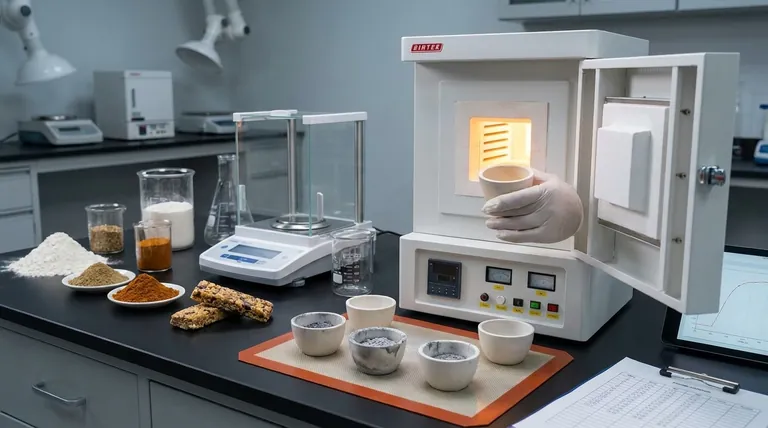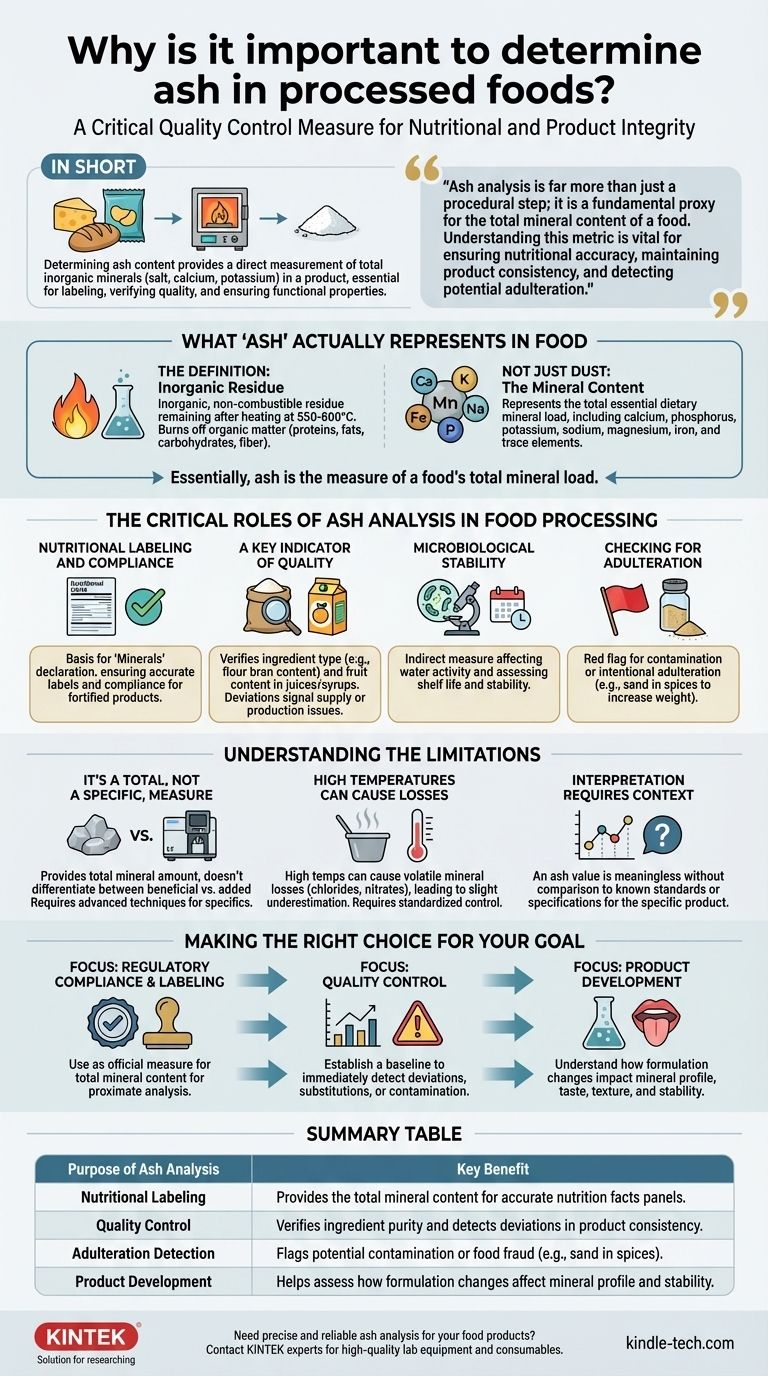باختصار، يعد تحديد محتوى الرماد في الأطعمة المصنعة إجراءً حاسمًا لمراقبة الجودة. يوفر قياسًا مباشرًا للكمية الإجمالية للمعادن غير العضوية - مثل الملح والكالسيوم والبوتاسيوم - الموجودة في المنتج الغذائي. هذه القيمة الواحدة ضرورية لوضع بطاقات التغذية، والتحقق من جودة المكونات، وضمان أن المنتج النهائي يلبي خصائصه الوظيفية المحددة.
تحليل الرماد هو أكثر بكثير من مجرد خطوة إجرائية؛ إنه مؤشر أساسي للمحتوى المعدني الكلي للغذاء. فهم هذا المقياس حيوي لضمان الدقة الغذائية، والحفاظ على اتساق المنتج، واكتشاف الغش المحتمل.

ماذا يمثل "الرماد" في الغذاء حقًا
التعريف: بقايا غير عضوية
يشير مصطلح "الرماد" إلى البقايا غير العضوية وغير القابلة للاحتراق التي تتبقى بعد تسخين عينة غذائية في درجات حرارة عالية جدًا (عادة 550-600 درجة مئوية).
هذه العملية، المعروفة باسم الحرق أو الرماد، تحرق بشكل فعال جميع المواد العضوية - وهي البروتينات والدهون والكربوهيدرات والألياف.
ليس مجرد غبار: المحتوى المعدني
ما يتبقى هو المحتوى المعدني الكلي للغذاء. هذه هي المعادن الغذائية الأساسية التي نحتاجها للصحة، مثل الكالسيوم والفوسفور والبوتاسيوم والصوديوم والمغنيسيوم والحديد، بالإضافة إلى العناصر النزرة.
بشكل أساسي، الرماد هو مقياس للحمل المعدني الكلي للغذاء.
الأدوار الحاسمة لتحليل الرماد في معالجة الأغذية
بطاقات التغذية والامتثال
يعد تحليل الرماد حجر الزاوية في التحليل التقريبي، وهو النظام المستخدم لتحديد ملف المغذيات الكبيرة والمعادن في الغذاء. غالبًا ما تكون قيمة الرماد الكلي هي الأساس لإعلان "المعادن" على لوحة حقائق التغذية.
يعتمد المنظمون على هذه البيانات لضمان دقة بطاقات الطعام وأن المنتجات المدعمة تحتوي على الكمية المعلنة من المعادن المضافة.
مؤشر رئيسي للجودة
يعد محتوى الرماد مؤشرًا قويًا على جودة ونوع المكونات المستخدمة. على سبيل المثال، في طحن الدقيق، يشير محتوى الرماد الأعلى إلى نسبة أكبر من النخالة في الدقيق، مما يؤثر على خصائص الخبز والقوام النهائي.
بالنسبة لعصائر الفاكهة والشراب، يمكن أن يساعد محتوى الرماد في التحقق من محتوى الفاكهة واكتشاف ما إذا كان قد تم تخفيفه أو غشه. يشير الانحراف عن قيمة الرماد المتوقعة إلى وجود مشكلة في سلسلة التوريد أو خط الإنتاج.
الاستقرار الميكروبيولوجي
يمكن أن تؤثر كمية ونوع المعادن في الغذاء، المعروفة بنشاط الماء، على قابليته للنمو الميكروبي. يوفر محتوى الرماد قياسًا غير مباشر يساعد في تقييم مدة صلاحية المنتج واستقراره.
التحقق من الغش
يمكن أن تكون قيمة الرماد المرتفعة بشكل غير عادي علامة حمراء للتلوث أو الغش المتعمد. على سبيل المثال، يمكن غش التوابل بالرمل أو المواد المطحونة لزيادة الوزن، مما يزيد بشكل كبير وغير قانوني من محتوى الرماد.
وهذا يجعل تحليل الرماد أداة فحص أولية بسيطة ولكنها فعالة للاحتيال الغذائي والسلامة.
فهم القيود
إنه قياس كلي، وليس محددًا
القيود الأساسية لتحليل الرماد هي أنه يوفر قيمة إجمالية أو خام. يخبرك بالكمية الإجمالية للمعادن ولكنه لا يميز بينها.
لا يمكنه أن يخبرك بكمية الكالسيوم المفيد من الرماد مقابل كمية الصوديوم من الملح المضاف. لذلك، تتطلب تقنيات أكثر تقدمًا مثل مطياف الامتصاص الذري (AAS) أو البلازما المقترنة حثيًا (ICP).
يمكن أن تسبب درجات الحرارة العالية خسائر
يمكن أن تتسبب درجات الحرارة العالية المستخدمة في الرماد في فقدان بعض المعادن المتطايرة، مثل الكلوريدات والنترات. وهذا يمكن أن يؤدي إلى تقدير أقل قليلاً للمحتوى المعدني الكلي الحقيقي.
يجب التحكم في الطريقة وتوحيدها بعناية لضمان أن تكون النتائج قابلة للتكرار والمقارنة.
يتطلب التفسير سياقًا
قيمة الرماد لا معنى لها بمعزل عن غيرها. قيمة "2% رماد" مفيدة فقط عند مقارنتها بمعيار أو مواصفات معروفة لذلك المنتج الغذائي المحدد.
إنها أداة مقارنة تستخدم لتتبع الاتساق بمرور الوقت ولضمان أن المنتج يقع ضمن نطاقه المتوقع.
اتخاذ الخيار الصحيح لهدفك
تحليل الرماد هو تقنية أساسية ذات آثار مختلفة اعتمادًا على هدفك.
- إذا كان تركيزك الأساسي هو الامتثال التنظيمي ووضع البطاقات: استخدم تحليل الرماد كمقياس رسمي للمحتوى المعدني الكلي المطلوب للتحليل التقريبي وحقائق التغذية.
- إذا كان تركيزك الأساسي هو مراقبة الجودة: قم بإنشاء محتوى رماد أساسي للمواد الخام والمنتجات النهائية للكشف الفوري عن الانحرافات أو استبدال المكونات أو التلوث.
- إذا كان تركيزك الأساسي هو تطوير المنتج: استخدم محتوى الرماد لفهم كيفية تأثير المكونات الجديدة أو تغييرات التركيبة على الملف المعدني للمنتج النهائي، مما يؤثر بشكل مباشر على الطعم والقوام والاستقرار.
في النهاية، يوفر هذا الاختبار البسيط لقطة قوية وفعالة من حيث التكلفة لجودة الغذاء وقيمته الغذائية وأصالته.
جدول الملخص:
| الغرض من تحليل الرماد | المنفعة الرئيسية |
|---|---|
| بطاقات التغذية | يوفر المحتوى المعدني الكلي لبطاقات حقائق التغذية الدقيقة. |
| مراقبة الجودة | يتحقق من نقاء المكونات ويكشف عن الانحرافات في اتساق المنتج. |
| اكتشاف الغش | يكشف عن التلوث المحتمل أو الاحتيال الغذائي (مثل الرمل في التوابل). |
| تطوير المنتج | يساعد في تقييم كيفية تأثير تغييرات التركيبة على الملف المعدني والاستقرار. |
هل تحتاج إلى تحليل رماد دقيق وموثوق لمنتجاتك الغذائية؟ تتخصص KINTEK في معدات المختبرات عالية الجودة والمواد الاستهلاكية لاختبار الأغذية بدقة. تساعدك حلولنا على ضمان الامتثال الغذائي، والحفاظ على جودة المنتج، وحماية علامتك التجارية. اتصل بخبرائنا اليوم للعثور على الأداة التحليلية المثالية لاحتياجات مختبرك.
دليل مرئي

المنتجات ذات الصلة
- فرن بوتقة 1800 درجة مئوية للمختبر
- فرن بوتقة 1700 درجة مئوية للمختبر
- فرن فرن عالي الحرارة للمختبر لإزالة الشوائب والتلبيد المسبق
- فرن الفرن الكتم 1400 درجة مئوية للمختبر
- فرن الفرن الصهري للمختبر ذو الرفع السفلي
يسأل الناس أيضًا
- ما هو بناء وعمل فرن الكتم؟ دليل للتسخين الدقيق والخالي من الملوثات
- ما هو الغرض من التكليس؟ تحويل وتنقية المواد للاستخدام الصناعي
- هل الفرن ماص للحرارة أم طارد للحرارة؟ اكتشف علم تدفئة المنزل
- ما هو الفرق بين البوتقة والفرن؟ فهم مصدر الحرارة مقابل وعاء الاحتواء
- ما هو الفرق بين الطباعة الحرارية (hot type) والطباعة الباردة (cold type)؟ اكتشف ثورة الطباعة



















